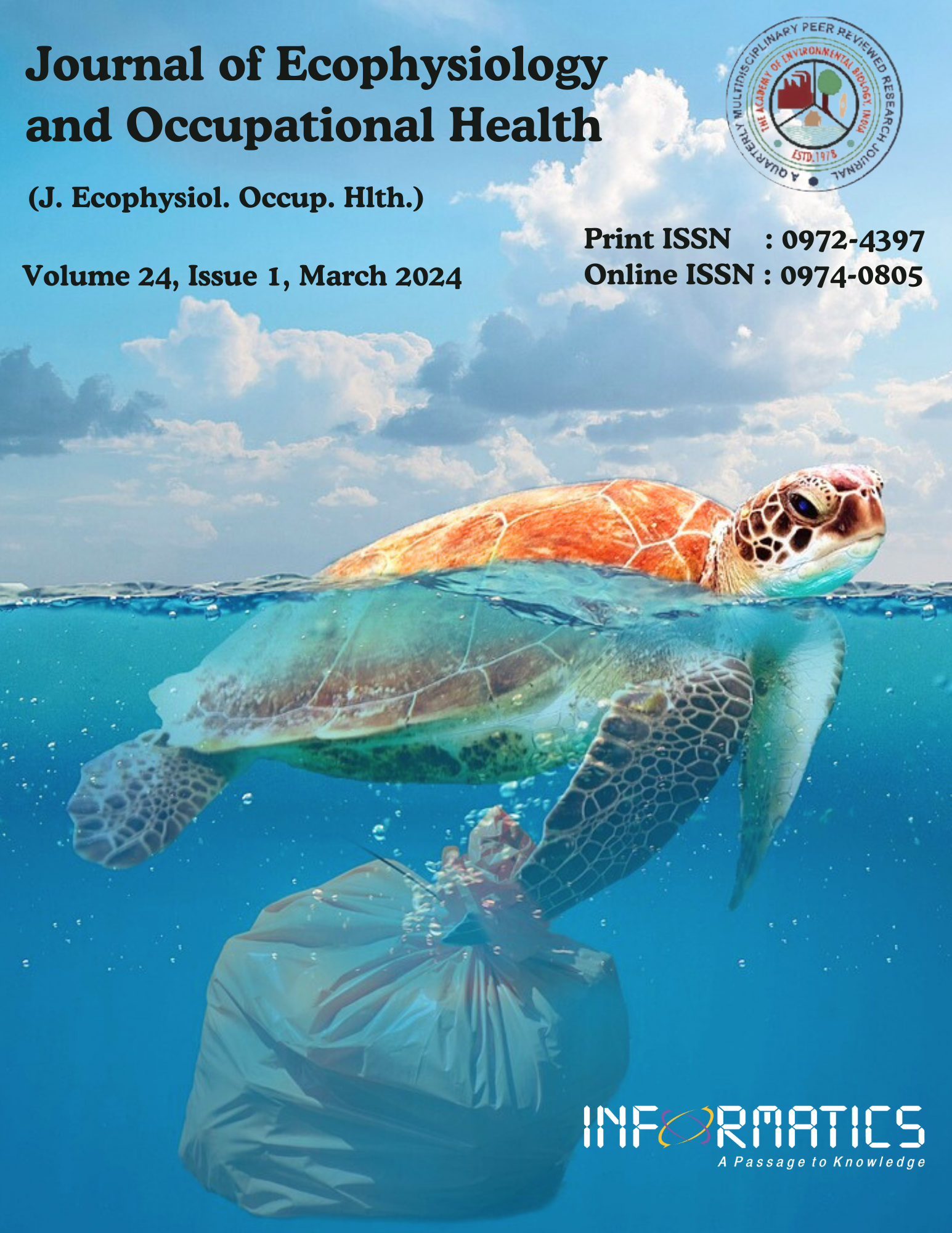Prevalence of Upper Cross Syndrome in Multipara Women
DOI:
https://doi.org/10.18311/jeoh/2024/35514Keywords:
Craniovertebral Angle, Forward Head Posture, Pectoralis Minor Tightness, Upper Cross SyndromeAbstract
Background: Upper Cross Syndrome (UCS) is now a commonly emerging syndrome in the presently existent population. In terms of clinical features, it can be defined as a postural disorder resulting from constriction of the pectoral muscles coupled with weakness of the trapezius and deep neck flexors, leading to forward-facing head stance, rounded shoulders, and kyphosis of the thoracic cavity. Comprehensive documentation of the incidence of this syndrome in multiparous communities is lacking in the literature. As a result, a study was carried out to ascertain the prevalence of UCS in multiparous women. Objective: To determine the prevalence of UCS in multiparous women. Methods: This study was approved by the Ethical Committee and the Protocol Committee (protocol no. 629/2022-2023). The subjects of the prospective cohort study were women who are multiparous and reside in Karad, Maharashtra, India. Using cluster sampling, 76 multiparous participants were included. Assessments were conducted for individuals within the age range of 23 to 58 years, evaluating them based on Craniovertebral Angle (CVA), Forward Head Posture (FHP), pectoralis minor tightness, and deep neck flexor strength. Results: This research looked at 76 participants involved in the study out of which 66.7% were prone to upper cross syndrome. Conclusion: The prevalence of UCS was notably high among multiparous women, with poor posture habits identified as a significant risk factor.
Downloads
Metrics
Downloads
Published
How to Cite
Issue
Section
License
Copyright (c) 2024 Mebin Sojan Thomas, Trupti Yadav

This work is licensed under a Creative Commons Attribution 4.0 International License.
Accepted 2024-01-10
Published 2024-03-04
References
Janda V. Introduction to the upper limb. Muscle Function Testing. 1983; 44-56. https://doi.org/10.1016/B978-0-407- 00201-2.50013-6 DOI: https://doi.org/10.1016/B978-0-407-00201-2.50013-6
Moore MK. Upper crossed syndrome and its relationship to cervicogenic headache. Journal of Manipulative and Physiological Therapeutics. 2004; 27(6):414-20. https:// doi.org/10.1016/j.jmpt.2004.05.007 PMid:15319765. DOI: https://doi.org/10.1016/j.jmpt.2004.05.007
Levangie PK, Lewek MD, Norkin CC. Joint structure and function: A comprehensive analysis. Philadelphia: F. A. Davis Company; 2019
Hoy DG et al. The epidemiology of neck pain, Best practice and amp. Research Clinical Rheumatology. 2010; 24(6):783-92. https://doi.org/10.1016/j.berh.2011.01.019 PMid:21665126. DOI: https://doi.org/10.1016/j.berh.2011.01.019
Gh ME et al. Prevalence of faulty posture in children and youth from a rural region in Iran. Biomedical Human Kinetics. 2012; 4:121-26. https://doi.org/10.2478/v10101- 012-0023-z DOI: https://doi.org/10.2478/v10101-012-0023-z
Lewit K. The functional approach. Journal of Orthopaedic Medicine. 1994; 16(3):73–4. https://doi.org/10.1080/1355 297x.1994.11719759 DOI: https://doi.org/10.1080/1355297X.1994.11719759
Mujawar J, Sagar J. Prevalence of upper cross syndrome in laundry workers. Indian Journal of Occupational and Environmental Medicine. 2019; 23(1):54. https://doi. org/10.4103/ijoem.IJOEM_169_18 PMid:31040591. PMCid: PMC6477943. DOI: https://doi.org/10.4103/ijoem.IJOEM_169_18
Mamania JA, Anap DB, Tanksale D. Validity and reliability of “on protractor” smartphone application for measurement of craniovertebral and cranio-horizontal angle. International Journal of Physiotherapy. 2017; 4(4):207-11 https://doi.org/10.15621/ijphy/2017/v4i4/154708 DOI: https://doi.org/10.15621/ijphy/2017/v4i4/154708
Dhage P, Anap D. Prevalence of an upper cross syndrome in Physiotherapy college students. A cross-sectional study. VIMS Health Science Journal. 2019; 6(1):10-3.
Ojukwu CP, et al. Breastfeeding-related neck pain: Prevalence and correlates among Nigerian lactating mothers. International Health. 2022; 15(4):383–8. https:// doi.org/10.1093/inthealth/ihac050 DOI: https://doi.org/10.1093/inthealth/ihac050
Akodu AK, Oti TG, Lawal AO. Breast hypertrophy, forward head posture, neck and shoulder pain-related disabilities and selected anthropometric variables of female undergraduate students. European Journal of Clinical and Experimental Medicine. 2022; 20(1):93-101. https://doi. org/10.15584/ejcem.2022.1.13 DOI: https://doi.org/10.15584/ejcem.2022.1.13
Krishnakumar A, Dabholkar TA, Dabholkar A. Assessment of scapular stability in postpartum females: A longitudinal study. Ergonomics in Caring for People. 2017; 91-96. https://doi.org/10.1007/978-981-10-4980-4_12 DOI: https://doi.org/10.1007/978-981-10-4980-4_12
Kataria J, Sindhu B, Pawaria S. Effect of mechanical neck pain on neck disability and scapula position among school teachers in Delhi and NCR. International Journal of Research in Pharmaceutical Sciences. 2021; 12(2):1260-5. https://doi.org/10.26452/ijrps.v12i2.4672 DOI: https://doi.org/10.26452/ijrps.v12i2.4672
Cai Z et al. The incidence of cervical spondylosis decreases with ageing in the elderly and increases with ageing in the young and adult population: A hospital-based clinical analysis. Clinical Interventions in Aging. 2016; 12(11):47-53. https://doi.org/10.2147/CIA.S93118 PMid:26834465 PMCid: PMC4716725. DOI: https://doi.org/10.2147/CIA.S93118
Singh J, Vyas N, Popli S, Banarwal S. Comparison of posture and anthropometric covariates of physically active and sedentary individuals in elderly population. European Chemical Bulletin. 2023; 12(10):55-64. https://doi. org/10.48047/ecb/2023.12.si10.007 DOI: https://doi.org/10.48047/ecb/2023.12.si10.007
 Mebin Sojan Thomas
Mebin Sojan Thomas







